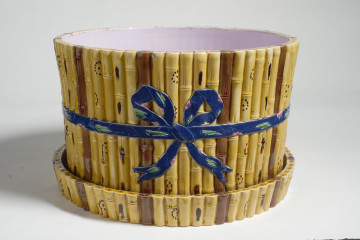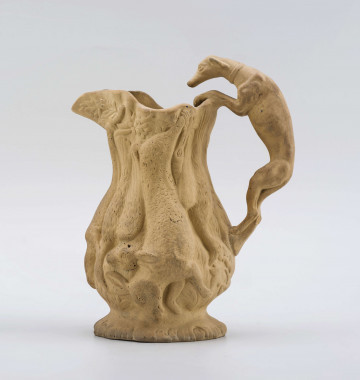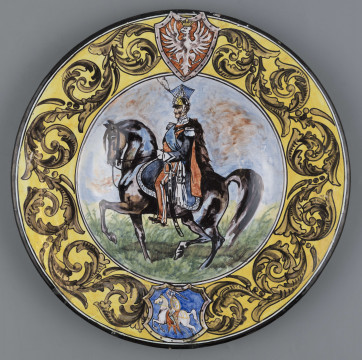
Cover
XIX/XX wiek, 2nd half of the 19th century
Castle Museum in Łańcut
Part of the collection: Majolica from Nieborów
Maiolica is a type of glazed ceramics with the colourful decoration of an extraordinary variety of motifs. It appeared in Europe in the 12th century thanks to merchants from Persia and Syria. In the 16th century, Italian maiolica decorated with impressive multi-coloured scenes, storje, became fashionable. These were figural mythological and genre compositions on the background of picturesque landscapes. The fashion for maiolica passed in the 18th century.
In the 19th century, Prince Michał Piotr Radziwiłł decided to renew the forgotten ceramic technique. The owner of Nieborów, which had fallen into neglect, decided to bring the whole property back from decline and industrialise it. In Wołyń, in Szpanów, he established the manufacture of furniture and a factory of artistic blacksmith products. In Nieborów, which became famous for its maiolica factory, he also established a sculpture workshop, the products of which were used to decorate the palace.
The ceramics factory employed specialists, local craftsmen and artists; around 1884, more than a hundred people worked there. The decorators were students of the Warsaw Drawing Studio led by Wojciech Gerson in 1871-1896 and women students of Warsaw porcelain painters.
The director of the ceramics factory was Stanisław Thiele, the son of a Polish insurgent and emigrant. The outstanding ceramist was educated in France and gained experience in the factory in Nevers. He supervised the production in Nieborów, designing and painting some pieces himself. The cooperation of two strong personalities, the owner of the estate and the director of the manufactory, was full of misunderstandings and dramatic turns. Despite the diverse production of utilitarian as well as purely decorative ceramics, the factory ceased to exist at the beginning of the 20th century. Today, the few examples gathered in museums are valuable collections of those unique products in the history of Polish ceramics.
The small platter from the Lublin collection presents the apotheosis of Jan III Sobieski. A full-plastic bordering surrounds the sketch-like scene. The king is portrayed on a mount with a lance, a banner and a Turkish turban under his hooves. In the background, the vaguely outlined tower of Vienna Cathedral reminds us of Sobieski's most significant victory.
Magdalena Norkowska
Author / creator
Dimensions
cały obiekt: width: 4 cm
Object type
dish
Technique
ceramic technique
Material
faience
Creation time / dating
Creation / finding place
Owner
The National Museum in Lublin
Identification number
Location / status

XIX/XX wiek, 2nd half of the 19th century
Castle Museum in Łańcut

1943 — 1850
National Museum in Lublin

1883 — 1885
National Museum in Lublin
DISCOVER this TOPIC
National Museum in Szczecin
DISCOVER this PATH
Educational path